A complete overhaul of the infantry tank concept
The former Matilda, or Matilda I, was a product of the 1929 financial crisis, a rather limited and compromised vehicle, badly suited to real battlefield operations. In 1936, it was in production, and the very same year, another parallel specification (A12), asked for a larger, better armed model, derived from the A7 prototype. In fact, the A12 was completely different from its "little brother", A11 (known as the "Matilda"), in size, weight, drivetrain, armament and crew. Development at the Royal Arsenal, Woolwich (which already designed the A7) lasted until 1938, when war seemed highly plausible, and the final A12 prototype trials were urgently passed, and an order came soon after, Vulcan Foundry having to build a first batch of 140 units until mid-1938.Design of the Matilda II
Of the previous A7 only three prototypes were built by Vickers, requested internally for potential Army or other contracts. They were built from 1929 to 1933, incorporated elements which largely influenced the A9 Cruiser Mk.I (notably the turret), and the A12 Matilda, including the drivetrain, suspension, and part of the armor design, but also later the A14, A17 and ultimately the Valentine. The third and last prototype, A7E3 (1933-37), probably had the biggest influence on the Matilda II, as it incorporated a twin diesel AEC C1 and a QF 3-pdr (47 mm/1.85 in) antitank gun. However, it was too lightly protected to serve as an infantry tank.The Matilda Mark II, or rather "Matilda II" (to avoid confusion with the sub-mark versions), or "Matilda Senior", was a 60,000 lbs machine, armed with the new QF 40 mm (1.57 in) gun, one of the many derivatives of the licence-built Bofors, which had an excellent rate of fire. The caliber seemed sufficient against most tanks of the time, generally equipped with a 37 or 47 mm (1.46-1.85 in) gun. The hydraulically-powered three man fully traversing turret was cast in one solid piece of hardened steel, almost cylindrical (slightly sloped), and tall enough to accommodate the main gun and a coaxial machine-gun, as well as the commander. The gun elevation was -15 +20 degrees. It was only fed with anti-tank rounds. The lack of HE ammunition was somewhat compensated by the machine-gun. But emphasis was put on armor. And indeed, this compensated easily for all its drawbacks during the war. With a 78 mm (3.07 in) frontal glacis and turret, far beyond any tank produced at the time (and even late into the war), the Matilda II was thought immune to most antitank guns, and naturally other tanks as well. This tank became legendary precisely for this rare quality. By comparison, the contemporary Panzer III and IV armour was 30 mm (1.18 in) strong, and the French B1, the most heavily armored tank on the continent, "only" 60 mm (2.36 in). The glacis was completed by thinner, but sloped nose plates, in a design largely influenced by the Christie tanks. The sides were 65-70 mm (2.56-2.76 in) and the rear glacis 55 mm (2.17 in) strong. The turret roof, hull roof and engine deck were all 20 mm (0.79 in) thick.
The weight of such armour conditioned other features in the design, starting with a twin-diesel AEC engine arrangement and Wilson epicyclic pre-selector gearbox, 6 speed transmission, with a Rackham clutch for steering. It also imposed the numerous double wheel bogies, with paired bell cranks with a common coil spring suspension, a rather classical solution based on the old Vickers Medium C design, which was intended to distribute the sheer mass of steel with moderate ground pressure, while sacrificing speed. By logical conclusion, its overall performances were quite limited, only infantry pace, which was precisely the task given to the A12 type, infantry support. However, the most troublesome piece of equipment was the paired "double decker" bus engines, linked to a common shaft, a solution which proved complicated to maintain, with many redundancies which often prevented movement when one of the two engines was damaged or broken down.
Production of the Matilda II
The very first model, a pre-series, was equipped with several features which will disappear with the production Mark I and Mark II. First, the suspension had three return rollers. They were replaced later by track skids, to ease production and maintenance. The turret was equipped (on the right) with a set of three smoke grenade launchers, in fact modified Lee Enfield mechanisms. On the turret left side took place a set of leather belts, to suspend a large protecting, rolled canvas. Later, these were replaced by a simpler metal tubular structure. When the war broke out in September 1939, only two Matilda IIs were serviceable. The other deliveries were pressed into service quickly after training. The same year, another order was placed to Ruston & Hornsby, and in 1940, to John Fowler & Co. of Leeds, and later, in 1941-42, to London, Midland and Scottish Railway, Harland & Wolff (Belfast, the famous shipbuilder of the Titanic), and, eventually, the North British Locomotive Company in Scotland. Production ended in August 1943 after a total of 2,987 units. It was a relatively costly tanks, and difficult to manufacture, requiring some special skills.Evolution from the MK.II to the Mk.V
The Mk.I was never really officialized, being the first, early batch delivered in 1939. Most were lost during the French campaign, in May 1940. They were characterized by a massive trench-crossing tail, as it was thought that a stalemate type of warfare was still possible. This feature proved useless, and the tail was never mounted on the first large-scale production variant, the Mark II. Like the Mark.I, it was equipped with a Vickers machine-gun, characterized by a large armored mantlet.By late 1940, this model was replaced by the lighter and more recent Besa model, of the same caliber, without a mantlet. This was known as the Matilda IIA Mk.II. The Besa was a British version of the Czechoslovak ZB-53. It was compact, air-cooled and belt-fed.
The next model, Mark III (still a Matilda IIA), saw the replacement of the old AEC engines for more modern twin Leyland diesel engine. This was sturdier and increased the range significantly.
The Mark IV (1941-42) introduced an improved Leyland diesel, and the turret leather belt fixation replaced by a fixed tubular mounting. The turret lamp was also removed. It was the main production version, with perhaps 1200 units built throughout 1942.
The Mark V (1943), was the last version, fitted with an improved gear box and Westinghouse air servo. Some attempts were made to replace the old QF-2pdr (40 mm/1.57 in) with a more efficient 6-pdr (76 mm/3 in) high velocity gun, already tested on the Cromwell, Cavalier and Centaur. In this hope, a Cromwell turret was tested with the Matilda hull, but production never materialized. Despite promising characteristics, combining firepower with a still efficient armor, the age of the model, suspension design and speed, led to the cancellation of any other developments.
Matilda II chassis adaptation and derivatives
The sturdy and largely available chassis of the Matilda seemed ideally suited to be adapted in many variants, but in fact, its slow speed and small turret ring prevented the development of many upgrades. Although, through special adaptation, the Matilda survived in many forms until the end of the war, it was retired from active duty in Africa by the end of 1942.Matilda II CS: (Close Support), a variant produced in small quantities and attached generally to mobile HQs. It was equipped with a 6-pdr (76 mm/3 in) howitzer, firing innocuous smoke shells. It was also capable of firing HE shells. The number of conversions is unknown. They were widely used in Europe, and later in Asia by Australian forces.
Matilda Scorpion: an operational mine-flail version, produced in two sub-versions, used at El Alamein, and in some British and Canadian operations in 1943 and 1944.
Matilda CDL: (Canal Defence Light), a late conversion, in mid 1944, with a new cylindrical turret containing a powerful searchlight. The CDL were converted either from Mark II or V chassis.
Matilda Hedgehog: an Australian regular Mk.V fitted with a folded 7-chambered spigot mortar, mounted on the rear engine hood. 6 were built, tested in May 1945, but never used operationally.
Matilda Frog & Murray, Murray FT: Australian flamethrower versions used in the Far East. Only 25 Frog conversions. Murray figures are unknown.
Matilda Tank-dozer An Australian bulldozer variant, mostly used by genie units to clear road obstacles and forested areas.
Other experiments : the Matilda Baron, three prototypes, mine-flail version; the Matilda-ZiS, a Lend-Lease Soviet prototype equipped with the high velocity ZiS 76 mm (3 in); the Matilda with A27 turret, to test the Ordnance QF 6 pounder (57 mm/2.24 in); and the Black Prince, a radio-controlled planned to be used for spotting antitank gun positions and demolition tasks. The conversion cost surged because of the fitting of a Wilson transmission, and the 60 ordered was cancelled.
The Matilda II in action : The campaign of France
When war broke out, only two Matilda II of the pre-series type were recently put in active service. They were soon joined by 20 others, passing the year in drilling exercises, before being shipped to France, were they came to serve with the 7th RTR, part of the British Expeditionary Force (BEF) Armored Division. They represented a minority of this unit\'s strength, the bulk of infantry tanks companies being taken by the older A11 Matilda "minor" (Matilda I). However, their armor was superior to the formidable French B1 bis, and they proved it during a single battle, at Arras. The entire Matilda II force available was committed during the hopeless attack of Arras, in the afternoon of May, 21, 1940, and after some success due to the lack of German efficient response, they were ultimately terminated by a handful of German 88 mm (3.46 in) FlaK 18 and 105 mm (4.13 in) field guns. Rommel had remembered how these AA guns were used in Spain years before. The surviving units withdrew from the field and were abandoned along with hundred of trucks and light vehicles at Dunkirk. They were sabotaged, but the Germans captured two of them, later repaired for tests.The "Queen of the desert"
When the war enveloped North Africa, the Matilda II truly became legendary, being nicknamed the "Queen of the desert" by its crews. The Matilda II\'s armor was still a powerful argument in all tank-to-tank engagements against Italian armor and AT guns during the early stage of the war (Operation Compass, late 1940). After that it proved itself time and time again against the DAK XVth Panzerdivision, still largely equipped with light Panzer IIs and early models of the Panzer III and IV, using inadequate guns. But Rommel\'s imaginative ambush tactics using AT guns proved a serious threat for the Matilda II, hampered by its slow speed and a somewhat troublesome, overheating engine, and troublesome steering under the harsh conditions of this specific theater of war. The already famous 7th RTR, reborn in Britain, fully reequipped with Mark IIs, took part both in the late 1940 campaign, and still ruled the battlefield until late 1941. Battle records included the conquest of Libya, seizing of Tobruk and Bardia, and later, Operation Battleaxe.The Germans used well placed AA batteries of 88 mm (3.46 in) guns with full efficiency against the Matilda. No less than 64 were lost during a single day of attack. Such a heavy toll raised questions about Matilda\'s fighting capabilities, but, nevertheless, it still proved efficient were opposing forces had nothing to respond with. The Pak-36, Pak-41, Pak-97/38 and sPzB-41 were all but useless. But the rapid-firing, accurate 88 mm (3.46 in), combined with skilled crews, flat ground with good visibility and the Matilda\'s slow motion, all conspired to condemn large-scale frontal attacks, using the Matilda. Another factor played for its demise. Like the Crusader, it was armed with a 1939-standard AT gun, good against 20 to 30 mm (0.79-1.18 in) armor, but not against the upgraded versions of the Panzer III and IV, which came in Africa in late 1941. However, with their limitations well-understood by the British command, they were once more succesful during Operation Crusader, especially the 1st and 32nd Army Tank Brigades, which were pivotal in the battle.
By mid-1942, the Germans had devised efficient infantry tactics using the Pak-38, and the long-barrel 50 mm (1.97 in) version of the Panzer III (Ausf J), which could deal with the Matilda. One solution was to upgrade the main gun, but with a turret ring of only 1.37 m (4.49 ft), no superior gun could be mounted without a major overhaul of the entire hull. Such a project was attempted in 1942, but after a single prototype was tested, the production was dropped for more modern late-generation cruiser tanks. In Africa, the Maltilda was gradually phased out by the Valentine. Damaged and worn out Matildas were retired and replaced by other models. Some were shipped to less threatening theaters, like in South and Eastern Africa, for operations against Italian Somaliland and Erythrea, in 1941. They were part of the 4th Royal Tank Regiment, taking part in the battle of Keren and all other operations in this sector. But the mountaineous terrain prevented any efficient large-scale use. Others were shipped to Greece (during the Balkan campaign), Crete and Malta, to prevent any German landing there. Matildas took part in the battle of Gazala (summer 1942) and the first battle of El Alamein, with further losses, and, just like the Crusaders, which were their opposite (fast, lightly armored, low silhouette), many were converted for other uses. It was no surprise that, when the second battle of El Alamein began in October 1942, around 25 Matilda Scorpions (equipped with mine-flail) were the only ones used in the front-line. When the M3 Lee and M4 Sherman, faster, and equipped with much potent guns, came in numbers, the remaining Matildas were shipped back to Britain, some for training, others as a reserve for further conversions.
In Russia
Already, by early 1942, the British was supplying the Red Army with Matildas. As many as 1084 Mk.II, III and IVs were shipped on the perilous arctic sea trip to Murmansk, until 1943. Mines, submarines, E-boats and the Luftwaffe sent 166 of them to the bottom of the sea. Most were of the diesel type, a kind of propulsion favored by the Russians. The first batch is reported to have taken part in the battle of Moscow in January 1942. Others fought around Leningrad, with Group North, others with the Center, and gradually South Groups, were weaker German allied armored forces were more common. Their crews disliked it for its slow speed and unreliable propulsion, and it compared badly to the KV-1 or the T-34. One of its major flaws was the abundance of snow and mud which gradually clogged the drivetrain and suspension. Its narrow tracks was also an issue during the winter and the Russians devised a simple expedient, wielding sections of steel to each link for better grip in the snow. As the losses rose, and were not replaced, the Matildas practically disappeared by 1943 on the Eastern Front. However, the "Queen of the desert"\'s career was not over yet.Matildas in Europe
The bulk of the last version, Mark V, were shipped to Eastern Asia by 1943, where they had a second active life, serving well until the end of the war. However, in Europe, surviving units were converted to other uses. In Italy, specialized versions for mine-warfare (Scorpion Mark.I and II) and HQ close defense versions armed with a smoke-firing howitzer, took part in the Allied offensive, and again during D-Day. During late 1944, modified Matilda CDLs (Canal Defense Light versions) were posted along canals, for night patrols against possible German counter-attacks. But they were a rare sight. At the later stage of the war in Africa, plans were drawn for a heavy artillery support version, equipped with a 152 mm (5.98 in) howitzer protected by a half-turret, like the Bishop. But its slow speed and large supplies of US-built Priests stopped the project before any prototype were built.The Matilda II in Asia
The last chapter of the Matilda II\'s wartime career came in 1943, when Allied forces were once more on the offensive. Large supplies of the Mk.IV and Mk.V were shipped to Australia. They took part in many operations throughout the reconquest of the south-eastern Pacific, favored by the lack of adequate Japanese AT guns or tanks. The Australian 4th Armoured Brigade took advantage of its sturdiness in the battle of Huon (October 1943), but also 1944 and 1945 during the Wewak, Bougainville and Borneo campaigns. The Australian forces also modified many of them for other purposes, like the flamethrowers Frog and Murray, or the genie tank-dozer. A heavy rocket-carrying version came too late for active operations. They also extensively used CS (close support) conversions.Captured Matildas
In May 1940, the Germans already seized two Matildas hastily sabotaged during the days of Operation Dynamo, and shipped them to the Kummersdorf Heer Test Center. They were fully aware of its armour thickness and devised appropriate tactics. An experimental conversion, the "Oswald", fitted with a shielded 5cm KwK L/42 gun and two Mg-42s, fought during the Balkan campaign. Later, with the fortune of war in Africa, the DAK managed to capture a dozen more in May-June 1941. They were repaired and affected to the 5th Pz.Rgt. of the 21st Pz.Div., and the 8th Panzer-Regiment of the 15th Panzer-Division. They were popular with their crews because of their armor, but caused confusion on the battlefield, despite the profusion of large painted crosses, large Nazi and army flags, and makeshift camouflages in some cases. Under the crude light of the desert, its silhouette was unmistakable, but the associated symbols difficult to spot. Those captured in too bad shape for repairs were kept as spare parts reserves. At least two or three had their turrets removed and mounted in concrete pillboxes, guarding strategic road junctions. On the Eastern Front, records of captured tanks are even more difficult to appreciate. But at least a dozen or so were seen with the Balkan cross in 1942-43, as testified by photographs of a German facility in Budapest, and in the field, or in Russian archives.Links about the Matilda II infantry tank
The Matilda II on WikipediaAbout captured Matildas (and other British tanks) in German service: Beutepanzers
| Matilda Mk.II specifications | |
| Dimensions | 15.11 x 8.6 x 8.3 ft (5.99 x 2.60 x 2.50 m) |
| Total weight, battle ready | 25 tons |
| Crew | 4 (driver, gunner, loader, commander) |
| Propulsion | 2 diesel 6-cyl AEC/Leyland 94/95 hp |
| Speed (on/off road) | 16/9 mph (26/14 km/h) |
| Range | 160 mi (257 km) |
| Armament | Main : 2-Pdr QF (40 mm/1.575 in), 94 rounds
Secondary: Besa 0.303 (7.7 mm) machine-gun, 2925 rounds |
| Armor | From 20 to 78 mm (0.79-3.07 in) |
| Total production | 2987 |
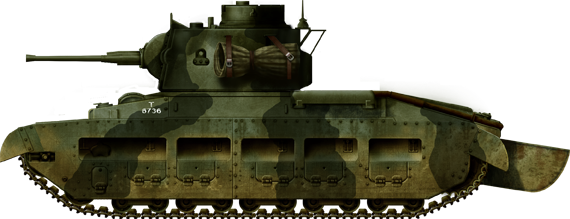
Infantry tank (A12) Matilda II Mk.I pre-series, "Gamecock", 7th RTR, 1st Armoured Brigade, British Expeditionary Force (BEF), western Belgium, May 1940. This is an early "long" version, equipped with the trench-crossing tail, mufflers, and Vickers coaxial machine-gun, protected by a large armored mantlet.
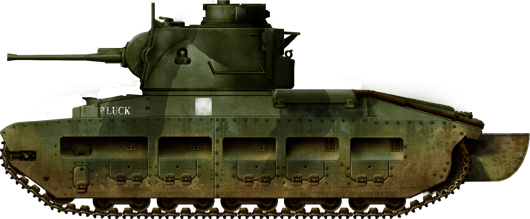
Infantry tank (A12) Matilda II Mk.I, "Good Luck", 7th RTR, 1st Armoured Brigade, British Expeditionary Force (BEF). The "Good Luck" was not true to its name for its crew. It blew up after a direct hit through the frontal hull from a German 88 mm (3.46 in), during the counter-attack at Arras, on May, 21, 1940.
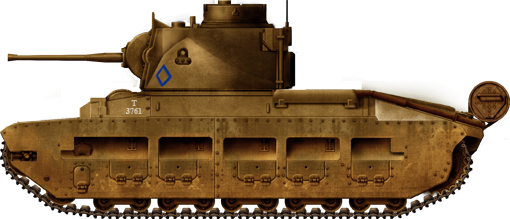
Matilda IIA Mark II, Libya, 1941 (one of the first delivered with the new compact Besa machine-gun, without mantlet). This is a vehicle from the First Armoured Division, the blue lozenge identifying it as a tank of a major of a junior regiment.
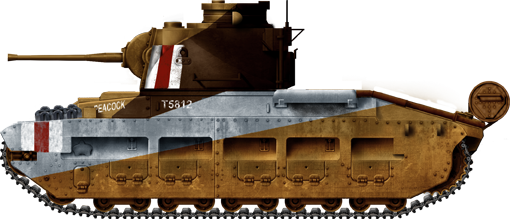
Matilda IIA Mk III, Lybia, fall 1941. This a tank from the 7th RTR, the white and red markings identifying the Royal Armoured Corps. The three color pattern with straight separations became mandatory. Such schemes, adapted to desert warfare, were adopted after visual disruption tests.
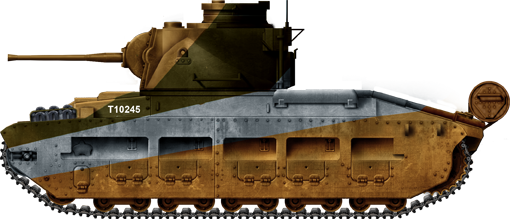
Matilda IIA Mk II in Libya, 1941, now preserved at Bovington. Notice the dark olive green variant three-tone camouflage.
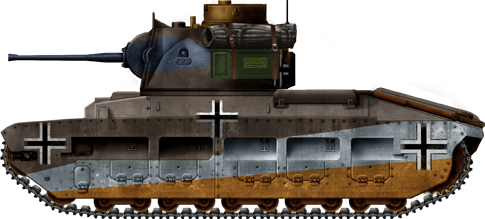
Infanterie-Kampfpanzer Mark II 748(e), Libya, early 1942.
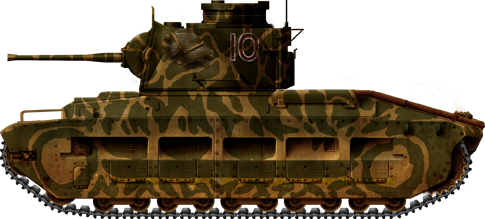
Infanterie-Kampfpanzer Mark II 748(e) (captured Matilda), 8th Panzer-Regiment, XVth Panzerdivision, Libya, 1942. Notice the makeshift camouflage and the absence of any Balkankreuz. In some cases a simple flag was displayed instead.
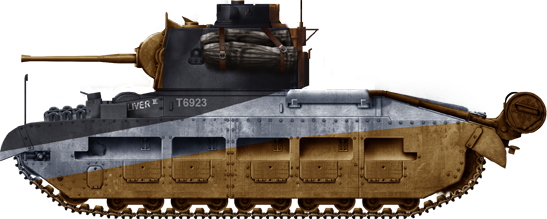
Matilda IIA Mk III "Gulliver II", 7th RTR (Royal Tank Regiment), Libya, fall 1941. The camouflage is a variant of the three-tone one, with dark-grey or dark-blue.
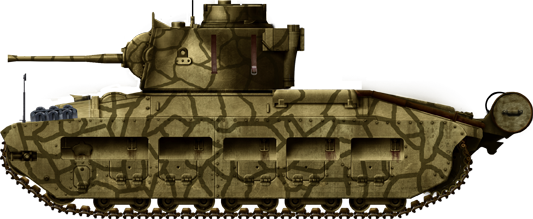
Matilda IIA Mk III at Malta, 1942. These tanks had an unique livery, with large sand color spots over the olive green factory color. The most well known is the "Griffin", of the 4th Independent Tank Platoon of the Malta Tank Squadron, RTR.

Matilda IIA Mk. IV with a particular spotted camouflage, reminiscent of the "Malta" livery seen above. This vehicle was photographed towing a crashed Boston hull, probably between Egypt and Libya.
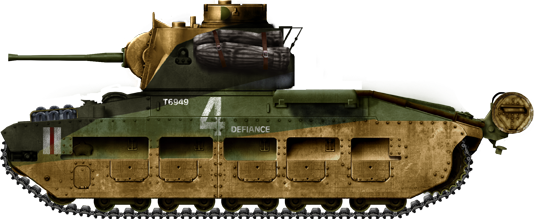
Many Matildas had been lost during the battle of Gazala, Operation Crusader, and the first battle of El Alamein. Surviving ones were placed in the reserve or used as reinforcements, like this Mk.IV (late production) "Defiance" of the 4th Royal Armoured Regiment, part of the VIIIth Army. Second battle of El Alamein, October 1942.
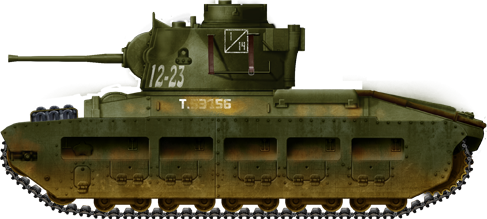
Russian Mark II Matilda of the 38th Armored Brigade, south-west front, May 1942. The USSR received 908 Matilda IIs through lend-lease, of the 1048 shipped . Losses at sea explained the difference.
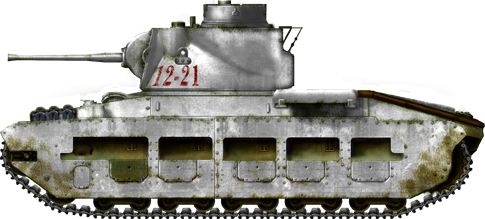
A Lend-Lease Russian Mark IV, with provisional washable white paint, Leningrad sector, winter 1942/43.
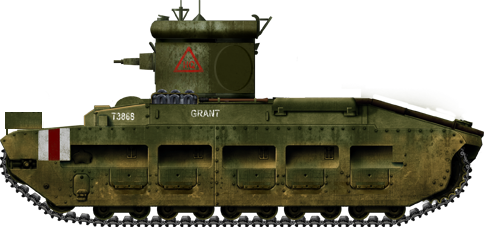
Matilda CDL of the 49th RTR - 35th Tank Brigade, north-eastern France, September 1944. The CDL (Canal Defence Light) was fitted with a new turret housing a powerful carbon-arc searchlight, for night operations. They served during the crossing of the Rhine, together with US Army LVT-4s.
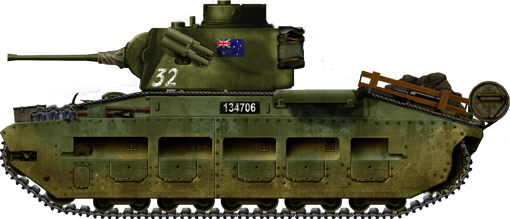
Matilda II Mk.V of the ANZAC 2/9th Armoured Regiment, at the battle of Tarakan, Borneo, May 1945.
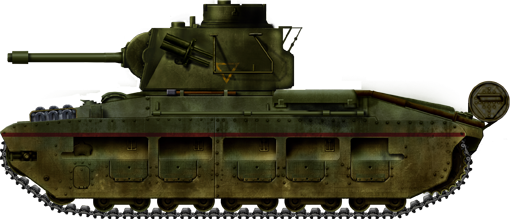
Matilda Frog (flame-thrower version), ANZAC 1st Tank Battalion (support) at the battle of Huon (New Guinea), October 1943.
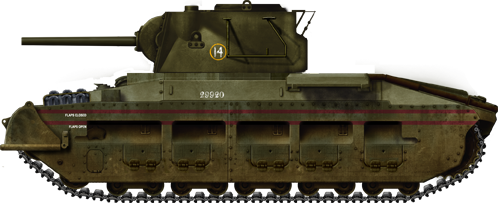
Matilda II CS (close support), ANZAC 1st Tank Battalion, battle of Huon (New guinea), January 1944. CS versions were also used in North Africa before, but they were used more extensively, together with Frog and Murray flamethrower versions, during this merciless campaign.
Matilda II gallery
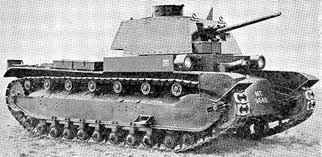
Medium Tank A7 prototype (1936)
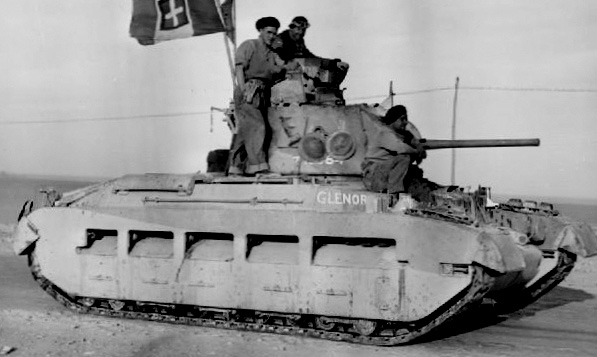
Matilda II tank on its way into Tobruk, displaying an Italian flag, 24 January 1941, during Operation Compass.
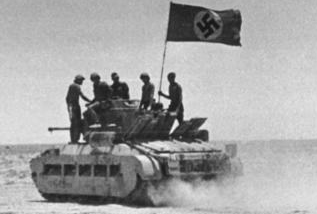
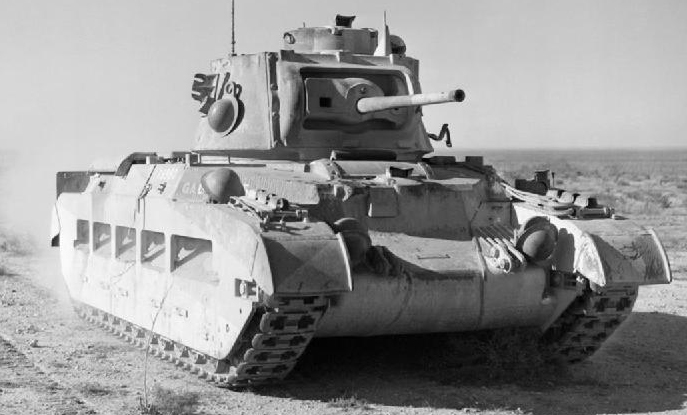
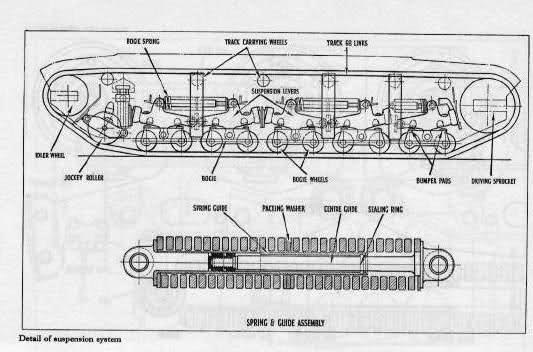
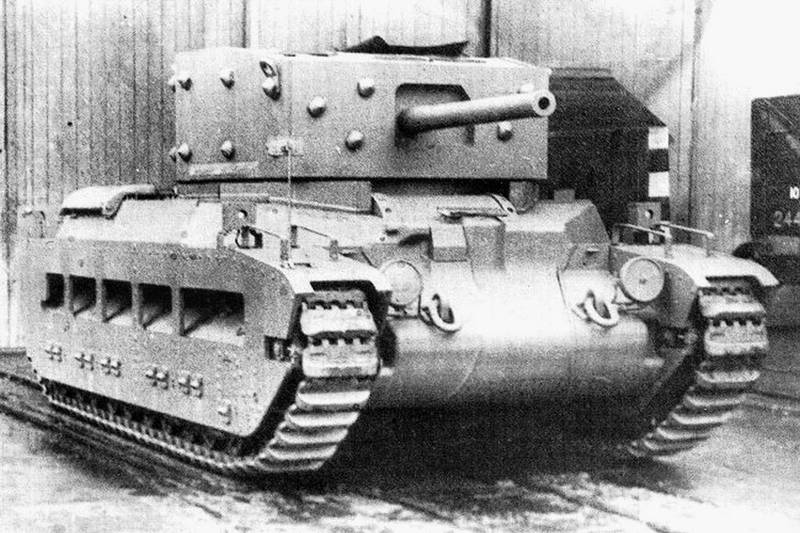
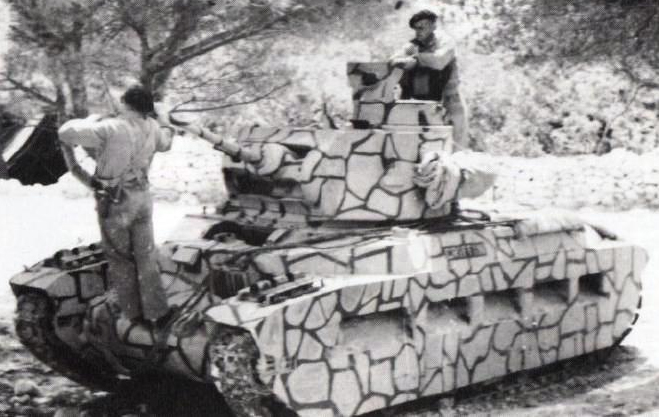
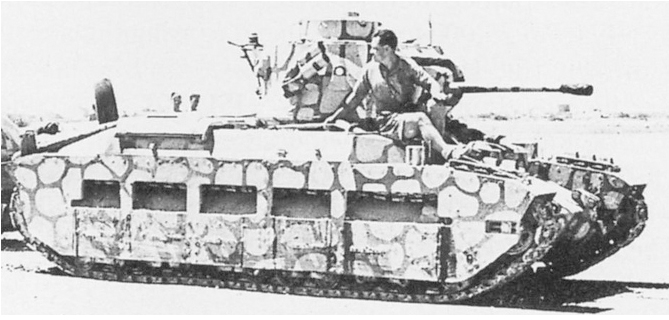
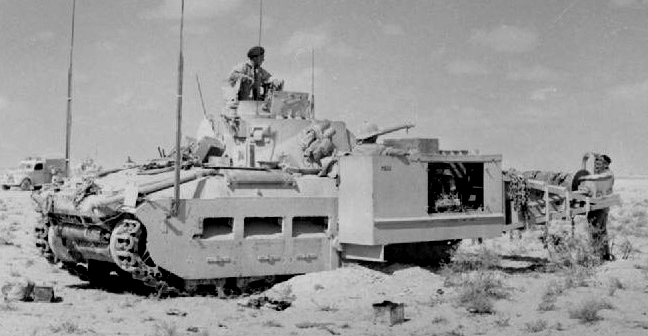

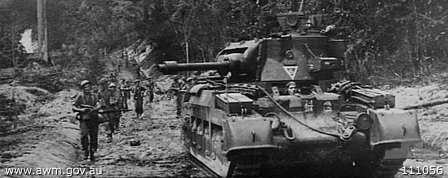
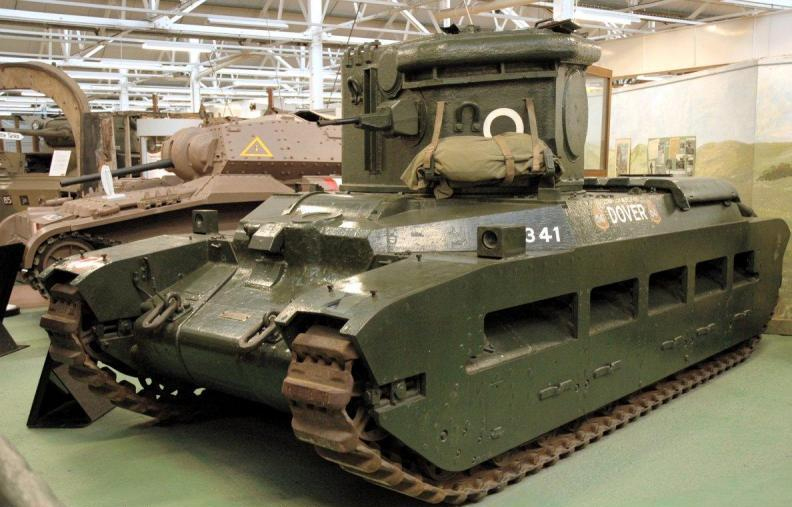
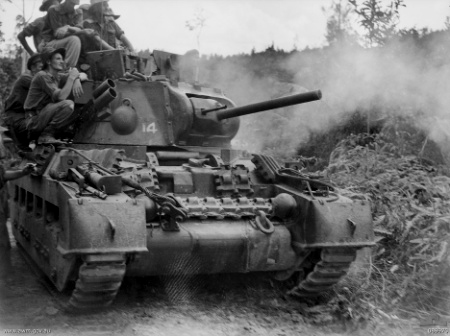
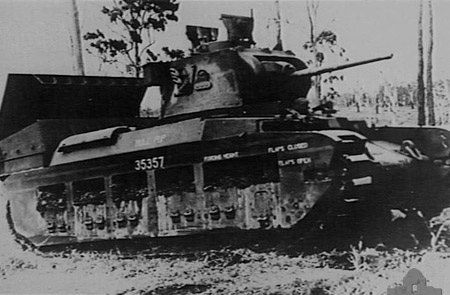

WW2 Tanks




























WW2 tanks posters

All Tiger tanks liveries.

Panther liveries and variants

WW2 Armour - All tanks











Tanks aces and single tanks series

Find more there

Museums, Movies, Books & Games
The Tanks and Armor in pop culture
Tanks and armored vehicles in general are only really grasped when seen first person: The mass, the scale, it's all there. Explore also the way tanks were covered in the movie industry, in books and in video games.Movies:
Best tanks movie on warhistoryonline.com
On imdb.com
On bestsimilar.com/
miltours.com
liveabout.com/
watchmojo.com
Video Games:
pcgamesn.com
historyhit.com
levvvel.com
vg247.com/best-tank-games
mmobomb.com/
alienwarearena.com

